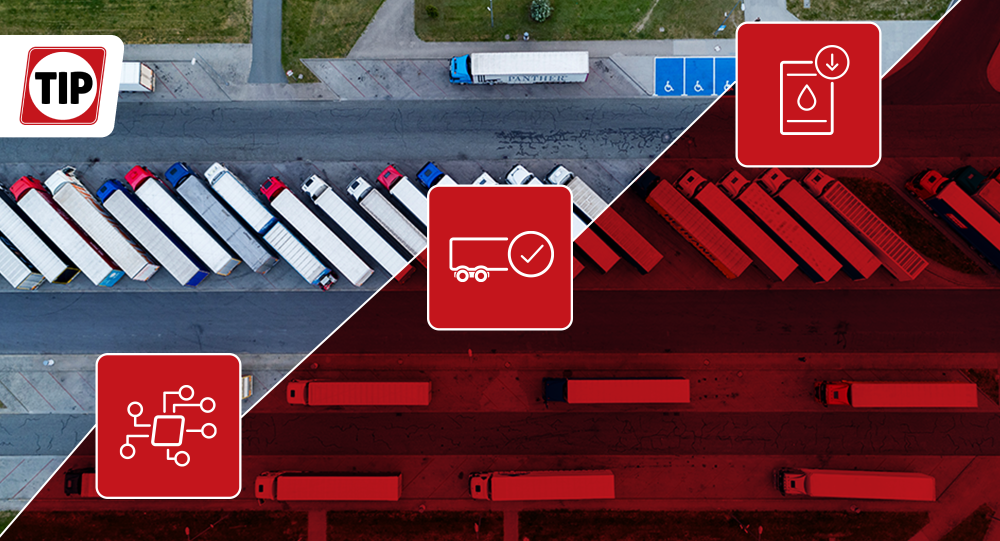Maximize the operational efficiency of used trucks & trailers
Freight transportation demand is expected to rise during the upcoming years, with road transport dominating the overall transportation activity, according to an outlook from EEA. However, fleet managers can still reduce long-term investment, gain total operational control and optimize operational efficiency of their existing fleet regardless of market changes. How?

Telematics for digital and data-driven efficiency
Telematics is a new technology allowing the transmission of data over great distances and the practice of processing and transforming them into useful information. From simple route planning to scheduled alerts for maintenance, vehicle tracking (telematics) offers advanced digital capabilities and helps fleet managers to :
-
Decrease operational costs (e.g., fuel saving)
-
Be more time efficient (e.g., mapping system)
-
Ensure operational efficiency (e.g., brake performance and tyre pressure)
-
Comply with environmental policies (e.g., reduce carbon emissions linked to fuel efficiency)
-
Enhance security for both the drivers and the cargo (e.g., refrigeration unit temperatures, door ‘open / close’ status, distracted driving etc.)
The adoption of fleet tracking and the real-time sharing of information presents a remote fleet management solution that guarantees the efficient and safe operation of the assets. For used trucks and trailers, telematics can have an essential impact on asset tracking, monitoring the maintenance and repair costs, as well as fuel efficiency, while enriching operational and financial performance.
Fleet resizing & Vehicle specifications for operating efficiency
Telematics not only help with better tracking operational metrics, but also provide evidence in the decision making of the right mix of the fleet. Based on the operational goals, utilization and location history of the fleet, as well as, maintenance costs, the number of assets can be adjusted accordingly and having the right assets available at the right time in the right location is easier than ever before.
Similarly, opting for bigger or optimized trailers, like the double-deck one, and reducing trailer weight will free up additional load capacity and support fuel efficiency (according to EPA, every 1,000 lbs. of weight dropped equals to 0.8% of fuel economy gained). Due to the existing increase in freight density and lighter-weight components production, the overall weight decrease becomes easier and operational and fuel efficiency can be reached (source: Fuel Efficiency Technology in European Heavy-Duty Vehicles, ICCT). However, when focusing on saving weight in your trailer specifications, it is critically important to understand the nature of the loads to not over, or under, specify the trailer as, at the end of the day, you need to ensure that your trailer specifications will stand up to the demands of your applications. For instance, for highly concentrated load, a trailer that is built to handle it is recommended. If the weight is reduced to increase the payload, the life of the trailer may be at risk.

Efficient driving & operating behavior for fuel efficiency
The way that a vehicle is operated can significantly influence the overall fleet performance. Efficient driving behavior is a factor that can positively influence the fuel consumption by 20% on aggressively driven cycles and by 5-10% on more moderately driven trips (Analyzing Vehicle Fuel Saving Opportunities, 2012). Even though external conditions like the general flow of traffic and strict transportation, don’t allow the creation of a standardized curriculum on the most fuel-efficient vehicle operation, there are simple practices to follow and apply a concerted behavior change
-
Gradual braking and accelerating can improve a vehicle’s fuel economy by 33% on highways and by 5% on city roads. To be as fuel-efficient as possible, take 5 seconds to accelerate your vehicle up to 20 kilometers per hour from a stop. Driving conservatively not only helps conserve fuel and save money, but it is also a safe practice for drivers (Review of the 21st Century Truck Partnership, Second Report, 2012).
-
Maintaining a steady speed can increase your fuel use by 20%. Of course, different vehicles reach optimal fuel economy at different speeds, so fuel efficiency generally decreases significantly at speeds above 50 miles per hour. The fuel economy benefits of reducing your speed is 7% to 14% (Review of the 21st Century Truck Partnership, Second Report, 2012).
-
Performing a maintenance routine can improve fuel economy by 40%. Factors such as tire pressure and axle alignment have been shown to have a measurable effect on fuel consumption. For instance, the effect of running with all tires underinflated by 20% is a 2-3% increase in fuel consumption. The maintenance check includes keeping the engine properly tuned, maintaining proper tire inflation, and using the recommended grade of oil.
Overall, there are many control features aimed at encouraging drivers to operate in a way that reduces fuel consumption, such as progressive shift, gear-down protection, road-speed governors, and smart cruise control. Since driver training and management can have significant potential for saving fuel, fleet operators should consider adopting them.
Upgrade your fleet with TIP!
When trying to determine all the above and ensure positive ROI, it is important that fleet managers seek out professionals with profound knowledge. TIP is a leading equipment service provider, across 120 locations in Europe and Canada, with more than 50 years of experience. From the sale of used equipment to maintenance and repair and telematic solutions for predictive maintenance, TIP provides all the services that a customer will require during the life cycle of a truck or trailer.
Contact one of TIP’s experts to maximize your transportation capacity and gain total control of your fleet https://www.tipeurope.com/contact-us!





















